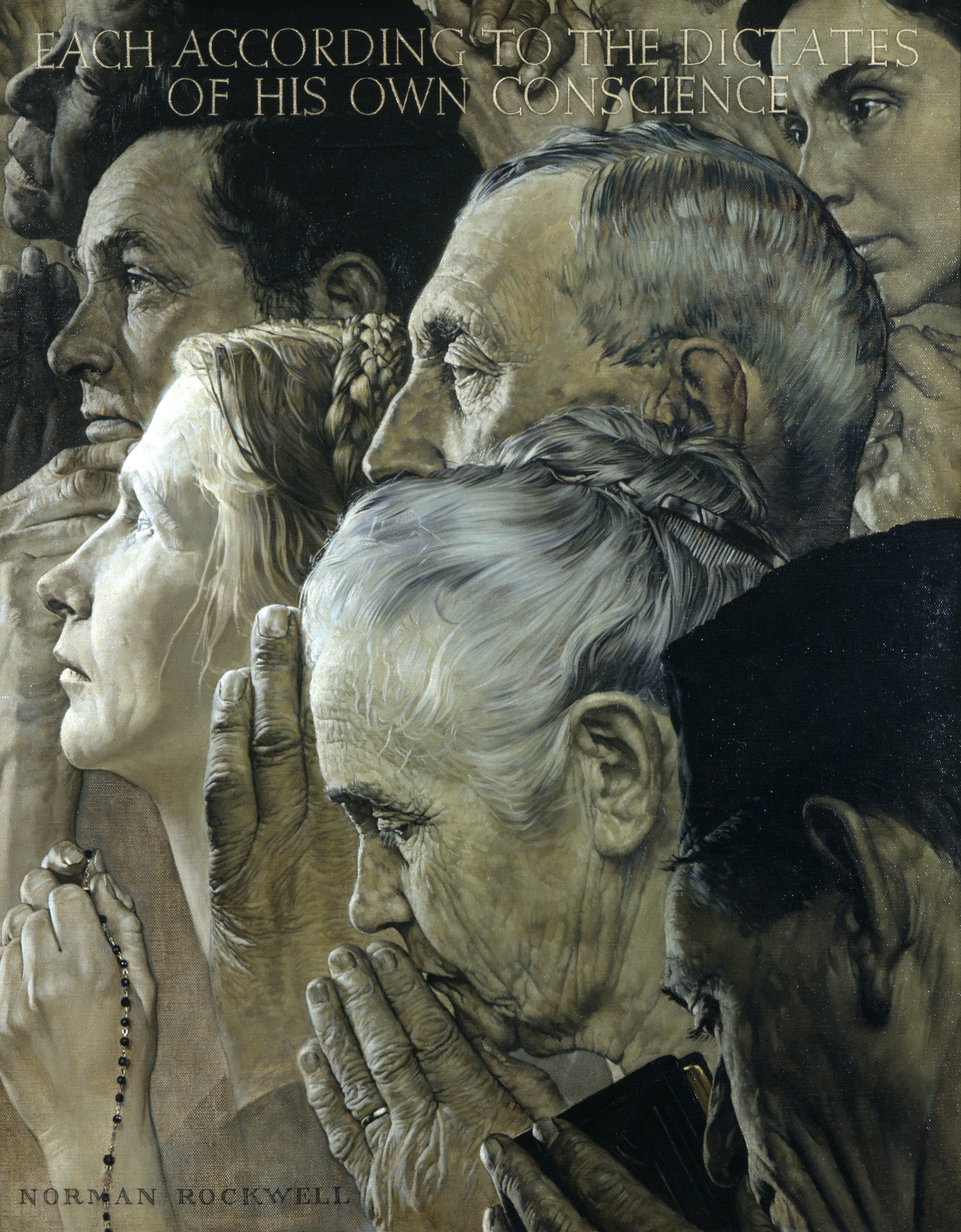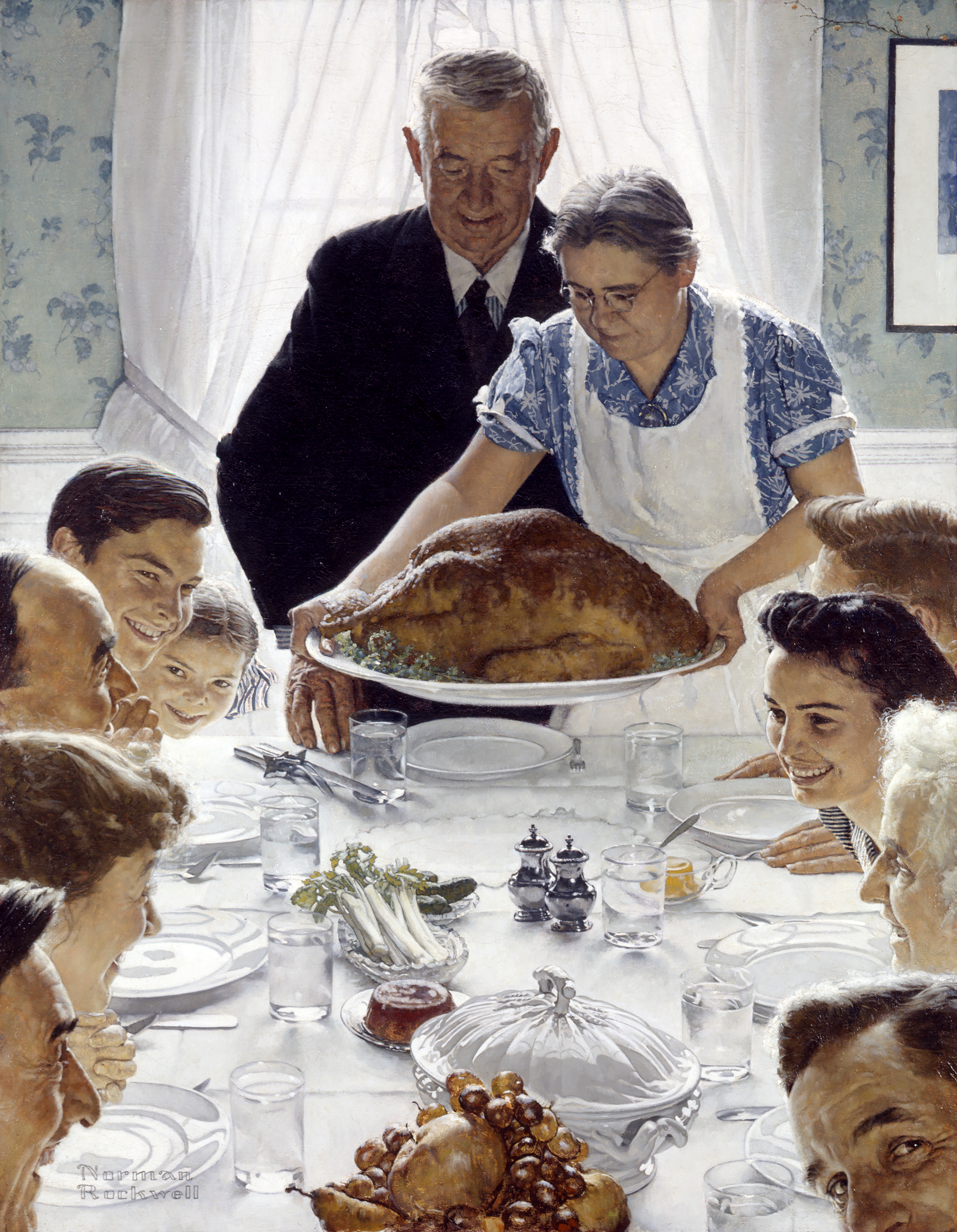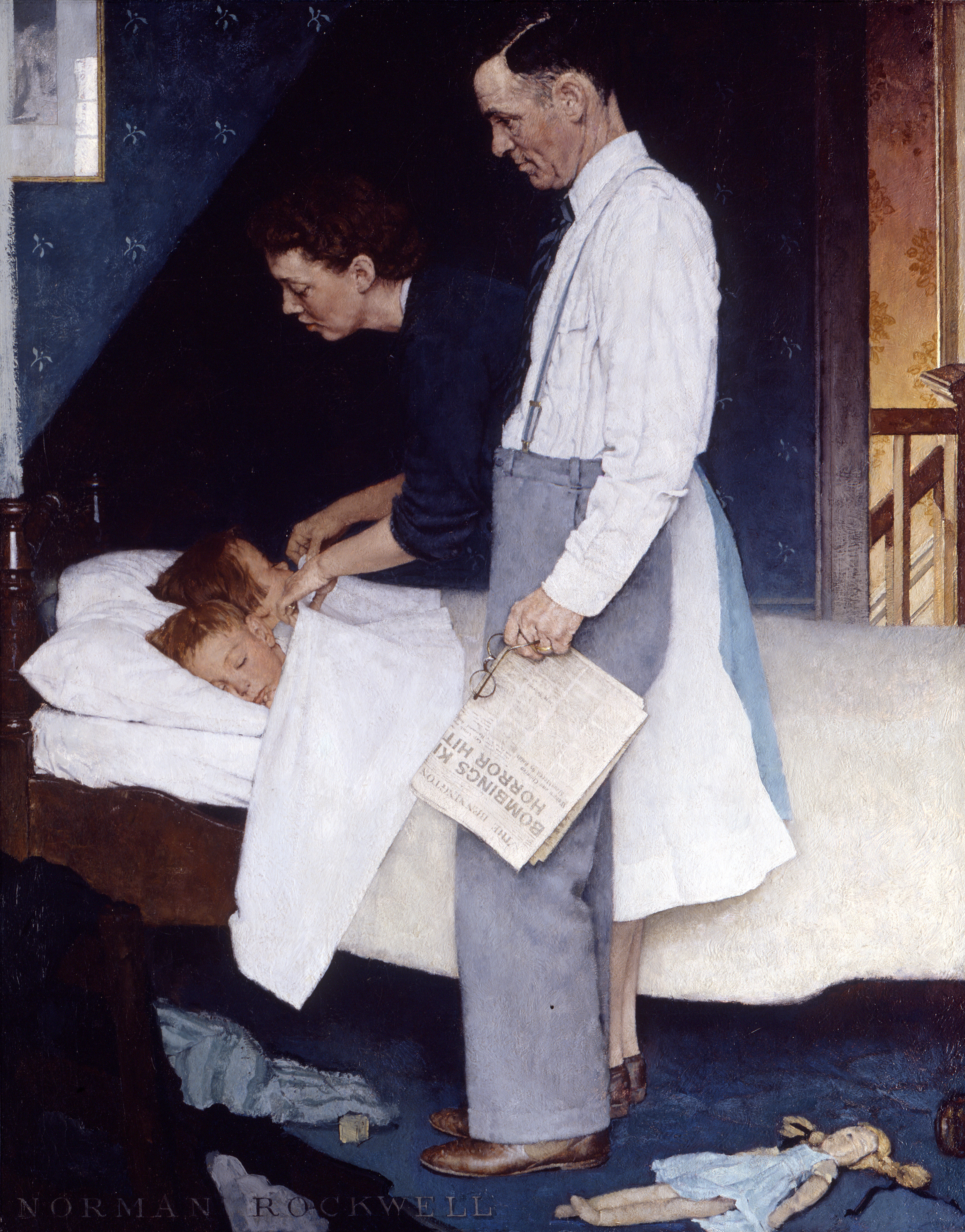Visit the Exhibit- Enduring Ideals: Rockwell, Roosevelt and the Four Freedoms
Overview:
This lesson will introduce students to the special exhibit Enduring Ideals: Rockwell, Roosevelt, and the Four Freedoms. Paintings, drawings, photographs, films and archival objects will be available for students to view and discuss as a group. A field trip to the exhibit will give students the opportunity to experience authentic artwork and archival materials, and encourage dynamic conversation about the life and work of Norman Rockwell. The exhibit will introduce students to the connections between art, history, and American culture, and inspire personal perceptions and interpretations. Students will analyze the composition of artworks using artistic vocabulary.
This lesson is designed for one half-day visit. If you are unable to visit the exhibition in person, you can view many of the exhibition items and related information online at https://rockwellfourfreedoms.org/
Enduring Ideals: Rockwell, Roosevelt & the Four Freedoms has five sections to explore:
The War Generation, Franklin Delano Roosevelt’s Four Freedoms, Rockwell’s Four Freedoms, The Artistic Response, and Freedom’s Legacy. The exhibit commemorates the 75th anniversary of the end of WWII and celebrates the history and values of the Four Freedoms.
The War Generation focuses on the Great Depression, the impending threat of war and the economic and racial inequalities present in society at that time.
Franklin Delano Roosevelt’s Four Freedoms includes archival documents and film of the president’s Four Freedoms speech, as well as photographs, films, political cartoons, World War II era posters and advertisements.
Norman Rockwell’s Four Freedoms focuses on the original paintings that Rockwell created to illustrate the ideals reflected in President Roosevelt’s Four Freedoms speech. Each painting was published in The Saturday Evening Post in February and March 1943. Each illustration appeared with a related essay by a noted author. Included in this section are unique studies for Freedom of Speech, and the Presidential Medal of Freedom presented to Rockwell in 1977 by President Gerald Ford.
The Artistic Response includes art and music that clarified, supported, and inspired the American people’s interest in President Roosevelt’s ideals.
Freedom’s Legacy offers a post-war perspective on President Roosevelt’s ideals and the impact of the work of Eleanor Roosevelt, which encouraged individuals around the world to work toward social change. Rockwell’s socially significant artworks focusing on civil rights and human rights are featured in this section of the exhibition.
Enduring Understandings/Essential Questions:
- President Roosevelt named the Four Freedoms as Freedom from Want, Freedom from Fear, Freedom of Worship, and Freedom of Speech.
- The Four Freedoms are for all citizens of the world.
- The Four Freedoms are reflected in our lives.
- Norman Rockwell’s pictures and the work of other artists include visual clues that help construct a narrative story.
- Visual images have the ability to influence the way we think and feel.
- Are the Four Freedoms named by President Roosevelt relevant today?
- Do all citizens of the world enjoy these freedoms in the same way?
- How are the Four Freedoms reflected in your life?
- What does “freedom” mean to you?
- How do artists interpret ideas in visual form?
- What elements of art make narrative storytelling possible?
- How do images inspire us and influence the way we think and feel?
- Grade
- K-4
- Theme
- Four Freedoms
- Length
- One half day field trip
- Discipline
- Art
- Vocabulary
- Authentic Archival Character Colors: primary, secondary, tertiary; Composition; Contrast; Cultural metaphors; Expressions; Eye Path; Monochromatic; Narrative Art; Representational Art; Setting; Symbol; Triangular Composition
Objectives:
- Visit the exhibition, Enduring Ideals: Rockwell, Roosevelt and the Four Freedoms, or view it online.
- Students will closely examine each of Norman Rockwell’s Four Freedoms illustrations and other works in the exhibition, each for historical relevance as well as for their artistic elements.
- Using Visual Thinking Strategies (provided as a resource), students will analyze artworks in relation to color, line, texture, shapes, and form.
- Students will describe how the elements of character, plot, and setting help to tell visual stories.
- Students will explore how specific details and expressions in artwork help to tell visual stories.
Background:
World War II began in 1939. The United States was not involved in the beginning of the war, however, President Franklin Roosevelt believed that the United States would eventually need to play a larger role. In January 1941, he made his speech to Congress. In his speech, President Roosevelt named the Four Freedoms, which he stated are the right of everyone in the world. After the speech, in an effort to convey the underlying message of the Four Freedoms, the President reached out to the art world for help. Many artists created works to reflect the meaning of these freedoms in the form of paintings, sculptures, prints, musical compositions, and more. Norman Rockwell thought a lot about these ideals. In February and March of 1943, his completed Four Freedoms illustrations were published in The Saturday Evening Post, each along with a related essay by a noted author. Exceedingly popular at the time and distributed widely as prints and posters, Norman Rockwell's illustrations raised over $132 million toward the war effort through the purchase of war bonds. Prints of Rockwell’s Four Freedoms were given as premiums when people purchased war bonds in varying denominations. His illustrations became the face of the Four Freedoms and they continue to represent the meaning of these freedoms today.
Materials:
Multimedia Resources:
Freedom of Speech
Freedom of Worship
Freedom from Want
Freedom from Fear
Franklin D. Roosevelt's Four Freedoms
Norman Rockwell Museum
Norman Rockwell's Four Freedoms
Norman Rockwell Museum
A Conversation with Ruby Bridges Hall
Norman Rockwell Museum
Womanpower: The Fight for the Four Freedoms
Norman Rockwell Museum
The Atlantic Charter: Hope for a New World
Norman Rockwell Museum
Classroom Supplies:
- Index cards/pencils
- If you are unable to visit the exhibit at once of the museums, the following is a link to the exhibit:
https://rockwellfourfreedoms.org/
Activities:
- Prior to the field trip, or to viewing the exhibition online, introduce students to the life and work of Norman Rockwell (see lesson Introduction to Norman Rockwell: American Illustrator.)
- Begin viewing the exhibition, in person or online, with Norman Rockwell’s Four Freedoms, and two or more works by other artists. Encourage students to participate and share something that they observe. Conversations about the art may focus on the use of color, line, texture, shape, form, detail, and meaning.
- Continue viewing the exhibition, section by section, coming together periodically to share student observations.
4. With students, identify and discuss symbols that reference aspects of American culture and twentieth century life.
- As a follow up activity in the classroom, invite students to create their own version of one of the Four Freedoms, or create a new piece that reflects their idea of freedom for our times.
- Exit Task: Have the students verbally or in written form on a index size paper, reflect on the visit to the exhibit, in person or online, by answering the following questions:
- What did you enjoy most about the exhibit?
- What is something that you learned that you didn't know before?
- What would you still like to know about Norman Rockwell and his art, or about other artists or artworks represented in the exhibition?
Assessment:
- Students will participate in group discussions (informal checks of understanding through questions).
- Students will apply information gained through this experience to their own artwork.
- Students will self-evaluate their understanding of the subject by completing the Exit Task.
Standards
This curriculum meets the standards listed below. Look for more details on these standards please visit: ELA and Math Standards, Social Studies Standards, Visual Arts Standards.
- VA:Cn11.1.1
- Understand that people from different places and times have made art for a variety of reasons.
- VA:Cn11.1.2
- Compare and contrast cultural uses of artwork from different times and places.
- VA:Cn11.1.3
- Recognize that responses to art change depending on knowledge of the time and place in which it was made.
- VA:Cn11.1.4
- Through observation, infer information about time, place and culture in which a work of art was created.
- VA:Pr6.1.1
- Identify the roles and responsibilities of people who work in and visit museums and other art venues.
- VA:Pr6.1.2
- Analyze how art exhibited inside and outside of schools (such as in museums, galleries, virtual spaces, and other venues) contributes to communities.
- VA:Pr6.1.3
- Identify and explain how and where different cultures record and illustrated stories and history of life through art.
- VA:Pr6.1.4
- Compare and contrast purposes of art museums, art galleries, and other venues, as well as the types of personal experiences they provide.
- VA:Pr6.1.K
- Explain what an art museum is and distinguish how an art museum is different from other buildings.
- VA:Re7.1.1
- Select and describe works of art that illustrate daily left experiences of one's self and others.
- VA:Re7.1.2
- Preceive and describe aesthetic characteristics of one's natural world and constructed environments.
- VA:Re7.1.3
- Speculate about processes an artist uses to create a work of art.
- VA:Re7.1.4
- Compare responses to a work of art before and after working in similar media.
- VA:Re7.2.K
- Describe what an image represents.
- VA:Re8.1.1
- Interpret art by categorizing subject matter and identifying the characteristics of form.
- VA:Re8.1.2
- Interpret art by identifying the mood suggested by a work of art and describing relevant subject matter and characteristics of form.
- VA:Re8.1.3
- Interpret art by analyzing use of media to create subject matter, characteristics of form, and mood.
- VA:Re8.1.4
- Interpret art by referring to contextual information and analyzing relevant subject matter, characteristics of form, and use of media.
- VA:Re8.1.K
- Interpret art by identifying subject matter and describing relevant details.



